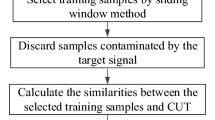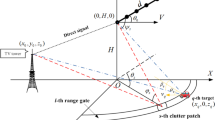Abstract
The extended factored approach (EFA) is believed to be one of the most efficient and practical space–time adaptive processing (STAP) algorithms for clutter suppression in an airborne radar system. However, it cannot effectively work in the airborne radar system with large antenna array for the huge computational cost and the lack of training sample. To solve these problems, a bi-iterative algorithm based on the persymmetric covariance matrix estimation is proposed in this paper. Firstly, the clutter covariance matrix is estimated by using the original data, the constructed spatial transformed data, the constructed temporal transformed data and the constructed spatial–temporal transformed data. Secondly, the spatial weight vector in EFA is decomposed as the Kronecker products of two short weight vectors. Finally, the bi-iterative algorithm is exploited to obtain the desired weight vectors. Thus, the improving EFA with small training sample demanding is realized. Experimental results demonstrate the effectiveness of the proposed method under small training sample support.






Similar content being viewed by others
References
L.E. Brennan, I.S. Reed, Theory of adaptive radar. IEEE Trans. Aerosp. Electron. Syst. 9(2), 237–252 (1973)
S. Chen, L.J. Kong, J.Y. Yang, Adaptive clutter nulling approach for heterogeneous environments. Circuits Syst. Signal Process. 34(3), 987–1000 (2015)
R.C. Dipietro, Extended factored space–time processing for airborne radar systems, in Signals, Systems and Computers, Conference Record of The Twenty-Sixth Asilomar Conference, IEEE (1992), pp. 425–430
R. Fa, R.C. Lamare, L. Wang, Reduced-rank STAP schemes for airborne radar based on switched joint interpolation, decimation and filtering algorithm. IEEE Trans. Signal Process. 58(8), 4182–4194 (2010)
D.Z. Feng, W.X. Zheng, A. Cichocki, Matrix-group algorithm via improved whitening process for extracting statistically independent sources from array signals. IEEE Trans. Signal Process. 55(3), 962–977 (2007)
J.P. Lasalle, The Stability of Dynamical Systems (SIAM Press, Philadelphia, 1976)
N. Li, G.L. Cui, L.J. Kong, X.B. Yang, MIMO radar moving target detection against compound-Gaussian clutter. Circuits Syst. Signal Process. 33(6), 1819–1839 (2014)
W.L. Melvin, A STAP overview. IEEE Aerosp. Electron. Syst. Mag. 19(1), 19–35 (2004)
C.D. Peckham, A.M. Haimovich, T.F. Ayoub, J.S. Goldstein, Reduced-rank STAP performance analysis. IEEE Trans. Aerosp. Electron. Syst. 36(2), 664–676 (2000)
I.S. Reed, J.D. Mallett, L.E. Brennan, Rapid convergence rate in adaptive arrays. IEEE Trans. Aerosp. Electron. Syst. 10(6), 853–863 (2007)
P. Stoica, Y. Selen, Cyclic minimizers, majorization techniques, and the expectation-maximization algorithm: a refresher. IEEE Signal Process. Mag. 21(1), 112–114 (2004)
Y.L. Tong, T. Wang, J.X. Wu, Improving EFA-STAP performance using persymmetric covariance matrix estimation. IEEE Trans. Aerosp. Electron. Syst. 51(2), 924–936 (2015)
H. Wang, L. Cai, On adaptive spatial-temporal processing for airborne surveillance radar systems. IEEE Trans. Aerosp. Electron. Syst. 30(3), 660–670 (1994)
C. Xiang, D.Z. Feng, H. Lv, J. He, H.W. Liu, Three-dimensional reduced-dimension transformation for mimo radar space time adaptive processing. Signal Process. 91(8), 2121–2126 (2011)
Z.C. Yang, Y.L. Qin, R.C. Lamare, H.Q. Wang, X. Li, Sparsity-based direct data domain space–time adaptive processing with intrinsic clutter motion. Circuits Syst. Signal Process. 36(1), 1–28 (2017)
B. Zheng, G.S. Liao, R.B. Wu, Y.H. Zhang, Y.L. Wang, 2-D temporal-spatial adaptive clutter suppression for phased array airborne radars. Acta Electronica Sinica 21(9), 1–7 (1993)
Y. Zhou, D.Z. Feng, G.H. Zhu, W.K. Nie, The post-Doppler adaptive processing method based on the spatial domain reconstruction. Signal Process. 111(c), 89–93 (2015)
Y. Zhou, B. Jiang, W.K. Nie, W.X. Zhang, The space–time processing method based on the spatial decomposition in airborne MIMO radar. Acta Electronica Sinica 45(10), 2348–2354 (2017)
Acknowledgements
The authors would like to thank very much the Handing Editor and the anonymous reviewers for their valuable comments and suggestions that have significantly improved the manuscript. This work was sponsored in part by National Natural Science Foundation of China under Grants 61503300 and 41601353 and the Scientific Research Plan of Education Department of Shaanxi Province under Grant 17JK0789.
Author information
Authors and Affiliations
Corresponding author
Rights and permissions
About this article
Cite this article
Zhou, Y., Wang, L., Chen, X. et al. An Improving EFA for Clutter Suppression by Using the Persymmetric Covariance Matrix Estimation. Circuits Syst Signal Process 37, 4136–4149 (2018). https://doi.org/10.1007/s00034-017-0743-y
Received:
Revised:
Accepted:
Published:
Issue Date:
DOI: https://doi.org/10.1007/s00034-017-0743-y




